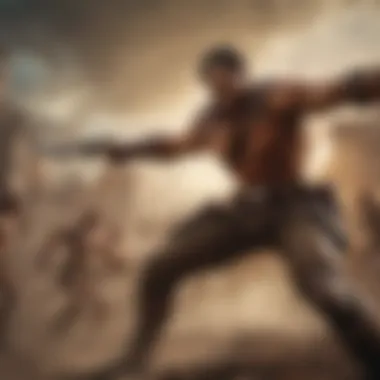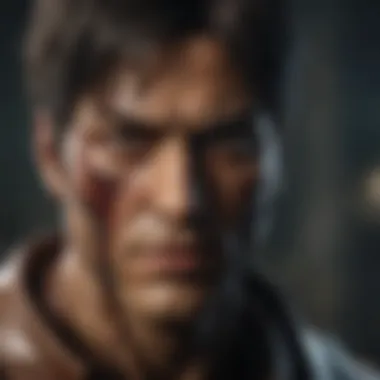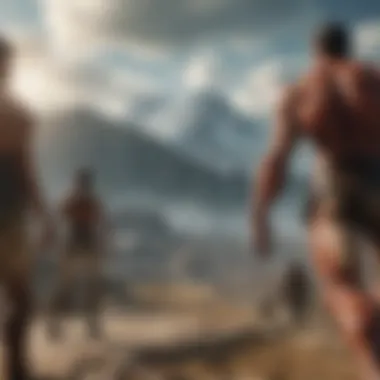Comprehensive Overview of Attack on Titan Season 4 Episodes


Intro
As the saga of Attack on Titan reaches a crescendo in its fourth season, fans around the world are eager for insights that illuminate the rich narratives, character developments, and thematic revelations embedded within each episode. This final season marks a significant juncture, as the series seeks to resolve longstanding questions while delving deeper into the emotional landscapes of its characters. In this article, we provide a structured exploration of each episode, detailing titles, air dates, and concise synopses that serve as gateways into the story.
The series has undergone substantial evolution since its inception, inviting not only seasoned viewers but also newcomers to engage with profound ethical dilemmas and heart-pounding action. By dissecting the episode list of Season 4, we aim to foster a clearer understanding of how the narrative arcs converge and how different elements resonate throughout this final stretch.
Key Elements of This Overview:
- Comprehensive breakdown of each episode's title and its air date.
- Brief synopses that encapsulate core events and character actions.
- Analysis of key themes and character arcs that evolve during the season.
This structured overview is designed to whet the appetite of fans and offer critical insights into the series' concluding moments, as we prepare to unpack the intricate world that Attack on Titan has built.
Prologue to Attack on Titan
Understanding the world of Attack on Titan is crucial for both newcomers and longtime fans. This article aims to provide insights into the series, particularly through its final season. The importance of exploring Season 4 lies not only in the resolution of long-standing story arcs but also in the opportunity to analyze character development and thematic depth.
Overview of the Series
Attack on Titan is a notable anime series that debuted in 2013. It is adapted from the manga of the same name, written by Hajime Isayama. The plot is set in a world plagued by giant humanoid creatures known as Titans, who devour humans. The narrative follows the journey of Eren Yeager, Mikasa Ackerman, and Armin Arlert as they fight for humanity's survival against these terrifying beings.
The series is not just known for its gripping action and compelling visuals. It delves into complex themes such as freedom, oppression, and the moral implications of survival. This multi-dimensional storytelling has contributed to its international acclaim and large fanbase. Season 4 holds particular significance as it concludes the saga, making it essential to understand the events leading up to this final chapter.
Significance of Season
The final season of Attack on Titan is critical for multiple reasons. First, it brings closure to the intense and intricate storylines developed over the previous seasons. As one delves into Season 4, they will find that it explores the consequences of the characters' choices, showcasing their evolution and the weight of their actions.
Moreover, Season 4 introduces new elements to the narrative. It shifts focus to the conflicts arising between different factions, particularly between Marley and the Eldians on Paradis Island. This added complexity enriches the story and captures the struggles of ideologies at play. The season also enhances the dramatic tension that the series is known for, with each episode presenting new challenges for the characters.
In summary, the introduction of Attack on Titan provides a vital context for appreciating the depth and intricacies of Season 4. By understanding the series' foundation and the significance of its concluding season, viewers can fully appreciate the narrative and thematic layers that Attack on Titan offers.
Episode List Structure
The organization of episode details is crucial for any comprehensive analysis. In the context of Attack on Titan Season 4, understanding the structure of the episode list allows fans and newcomers alike to navigate the complexity of the narrative seamlessly. By arranging episode information into digestible sections, the article enhances the understanding of character development, plot twists, and thematic elements throughout the season.
Format of Episode Details
Title
The title of each episode serves not only as a label but also as a thematic indicator. Each title often encapsulates critical aspects of the episode, providing insights into the events that will unfold. For instance, a title may hint at character struggles or pivotal plot developments. This characteristic is beneficial for readers because it creates anticipation and encourages them to engage more deeply with the story.
Uniquely, the titles can inspire discussion among fans, as they often reflect key themes or motifs. However, a disadvantage is that some titles may feel cryptic, potentially alienating viewers unfamiliar with the series' context.
Air Date
The air date of each episode is an important detail as it contextualizes the release within a specific timeline. It helps viewers track the progression of the story and the pacing of character arcs. These dates can also reflect changes in production and audience reception over time. This characteristic makes including air dates essential, as it deepens the connection between the viewers and the unfolding events of each episode.
One notable feature of air dates is how they can influence viewership patterns. An episode released during a high-traffic viewing period may garner more attention, but this could also create pressure on the production team to deliver a standout episode. This pressure can lead to inconsistency, which, while intriguing, also carries risks for the narrative quality.


Synopsis
The synopsis of each episode provides a concise overview of what to expect without giving away significant spoilers. This feature is vital for maintaining intrigue and clarifying plotlines for newly engaging viewers. Through succinct language, synopses can articulate the underlying themes and character motivations, which enhances viewer comprehension and engagement with the storyline.
A well-written synopsis is a balancing act; it must intrigue without revealing too much. It serves as a starting point for discussions among fans, often leading to deeper analysis of character arcs and thematic representations. However, a common disadvantage can be overly vague synopses which may blur essential narrative elements, thus potentially confusing new viewers.
Importance of Tracking Episodes
Tracking each episode is fundamental for understanding Attack on Titan Season 4 in its entirety. It helps fans recognize not only the progression of the storyline but also the evolution of pivotal character arcs. By systematically documenting the episode list, viewers can cross-reference key events and themes, fostering a more profound appreciation of the series.
This practice also encourages discussions about how each episode fits within the broader narrative fabric of the final season. As the complexities grow, the dialogue becomes richer. Whether a casual viewer or a dedicated fan, tracking episodes establishes a unique viewing experience that enhances both enjoyment and comprehension.
Attack on Titan Season Episode Overview
The final season of Attack on Titan carries immense significance for both the narrative and its dedicated fans. As the series wraps up complex storylines and character arcs, the episode overview serves as a critical guide to understanding the nuances of the concluding events. Each episode builds upon the last, leading to a dramatic climax that leaves a lasting impression on viewers. This structured breakdown allows for easier tracking of character development, thematic depth, and key plot points. Knowing the air dates and synopses of each episode fosters a better appreciation of the storytelling craft and the emotional weight carried throughout the season.
Episode One: The Final Season Begins
The inaugural episode marks a pivotal transition for the series. Titled "The Final Season Begins," this episode establishes the stakes and sets the tone for what is to come. It immediately showcases the shifting dynamics between familiar characters and the formidable forces they face. The opening sequences introduce new settings and tensions, emphasizing the changing world of Attack on Titan. Here, audiences realize that the confrontation with Titans is not merely a fight for survival but also a struggle for ideological supremacy.
Episode Two: The Threat of Eren Yeager
In this episode, titled "The Threat of Eren Yeager," fans dialogue intensifies around Eren’s transformation and motivation. The episode provides captivating insights into Eren's newfound abilities and his controversial choices, as former allies grapple with their feelings towards him. This episode is crucial as it deepens the understanding of Eren’s role within the narrative, exemplifying his duality as both hero and potential antagonist, a theme that resonates throughout the season.
Episode Three: Confrontations
"Confrontations" serves as a vital turning point in the series. Tension mounts as various characters face off against each other, each representing differing ideologies. The episode highlights the complexity of relationships tested by war, emphasizing that conflicts do not solely exist between nations, but also within individuals. This theme encapsulates the essence of the series, reflecting the struggle to reconcile personal beliefs with duty.
Episode Four: The War Hammer Titan
The introduction of the War Hammer Titan significantly alters the course of the series. This episode reveals the power dynamics within the Titan shifters, portraying the fragility of alliances. The War Hammer Titan becomes a symbol of the immense stakes involved in the ongoing conflict. Audiences feel the weight of the characters’ choices as each decision leads to unexpected consequences.
Episode Five: The Great Titan War
In "The Great Titan War," the dire nature of conflict becomes apparent. The scale of battle escalates, drawing viewers into the chaos and desperation experienced by the characters. This episode is essential for understanding the broader implications of the war, showcasing how it affects not just individuals but entire communities. The visuals enhance the narrative, illustrating the horrors of war and its tragic costs.
Episode Six: The Aftermath of War
This episode examines the consequences of the preceding battles. Following the chaos, "The Aftermath of War" provides a reflective tone as characters deal with loss and guilt. The exploration of trauma showcases the human side of conflict, offering depth to character motivations. This episode encourages viewers to ponder the long-term effects of their actions.
Episode Seven: Paths of the Past
"Paths of the Past" invites audiences to explore backstories that shape character motivations. This episode offers revelations about the history of Titans, enriching the lore of the series. Understanding the past helps viewers to grasp the present conflicts and the characters' struggles, emphasizing the importance of context in storytelling.
Episode Eight: Tension Among Allies
In this episode, alliances are tested as tension among characters comes to a head. "Tension Among Allies" illustrates the thin line that exists in friendships when faced with difficult situations. This builds upon the narrative complexity, forcing characters to reconsider their loyalties and beliefs. The dialogues in this episode are particularly impactful, showcasing the emotional stakes at play.


Episode Nine: The Truth Revealed
The title of this episode is indicative of its content. "The Truth Revealed" confronts the lies and misconceptions that have permeated the narrative. Here, characters uncover unsettling truths about their world, challenging their perceptions and beliefs. This episode crucially alters character trajectories, making way for unexpected alliances and further complications in the story.
Episode Ten: The Homecoming
As the title suggests, "The Homecoming" is a pivotal moment where characters return to places that hold significance to them. This episode evokes a sense of nostalgia but also brings forth painful memories, reinforcing the idea that home is not always a place of comfort. Viewers witness characters confront their pasts, shaping their present actions and decisions.
Episode Eleven: A New Beginning
Following the chaos, "A New Beginning" suggests potential for change and growth. It sets the stage for upcoming conflicts while offering a glimpse of hope for the characters. This episode focuses on how circumstances can change perspectives, allowing for character evolution as they grapple with their places in the world.
Episode Twelve: The Final Battle Approaches
As tensions rise, "The Final Battle Approaches" heightens the anticipation for the climactic conflicts ahead. The pacing quickens, and viewers are drawn into the urgency of the situation. This episode underscores how preparation for battle is as critical as the battle itself, reflecting the series' themes of strategy and foresight.
Episode Thirteen: Reflections
In "Reflections," characters take time for introspection. This episode is quieter than prior installments, allowing for character development through personal insights. The reflective moments provide depth to the narrative, enriching the audience's understanding of the characters’ motivations and aspirations.
Episode Fourteen: The Clash of Ideologies
The ideological battle intensifies in "The Clash of Ideologies." The episode explores how different perspectives on freedom and authority can lead to conflict. It challenges viewers to think critically about the underlying philosophical questions that have propelled the narrative thus far, reinforcing the series' depth and complexity.
Episode Fifteen: Last Stand
Titled "Last Stand," this episode encapsulates the culmination of building tensions throughout the season. Stakes are at their peak as characters confront both internal and external threats. The emotional weight of sacrifices made is palpable, leaving viewers to ponder the cost of war and the choices characters make at crucial moments.
Episode Sixteen: The Final Episode
The final episode concludes the journey with revelations that leave a lasting impact on audiences. It ties together loose threads from the previous episodes while challenging viewers' expectations. As the title hints, this episode encapsulates the essence of the series, offering closure to some characters while leaving others with questions about their futures.
The final season is not just an ending, but a reflection of the journey taken by each character.
The overview of Attack on Titan Season 4 episodes provides a structured lens through which fans can appreciate the complexity of storytelling, character development, and thematic resonance. This deeply layered approach ensures that both avid viewers and newcomers can engage with the rich tapestry of events leading to the series' conclusion.
Character Arcs in Season
The character arcs in Season 4 of Attack on Titan are crucial for the narrative's impact. This season marks the culmination of several years of development, with significant transformations and conflicts emerging among the central characters. Understanding these arcs helps viewers appreciate the complexities of the story and the evolution of its characters. Each transformation serves specific plot functions, highlighting themes such as freedom, responsibility, and the cost of war.
Eren Yeager's Transformation
Eren Yeager's journey in Season 4 represents a radical shift from the protagonist many fans once knew. His evolution is pivotal to the season's narrative. Initially driven by a desire for freedom and justice, Eren's character becomes an embodiment of moral ambiguity. His drastic choices raise questions about his motivations and the overall philosophy of freedom. By adopting extreme measures, Eren challenges the conventions of heroism.
Mikasa and Armin's Development
Mikasa and Armin provide contrasting perspectives in Season 4, which enriches their character development. Mikasa's unwavering loyalty to Eren is tested throughout the season. While she embodies strength and determination, her internal conflict grows palpable as Eren's methods become more radical. This duality challenges her character, forcing her to consider what loyalty truly means in a world fraught with moral dilemmas.


Armin, on the other hand, transitions from a passive role to a more decisive figure. As the inheritor of the Colossal Titan, he faces the weight of his responsibilities. His character highlights the importance of strategy over brute force. Armin’s development culminates in pivotal moments where he must confront Eren’s choices. Together, their arcs present a nuanced examination of friendship, trust, and the burdens carried during warfare.
New and Returning Characters
Season 4 introduces a range of new characters while re-establishing familiar faces. Key new characters like Gabi Braun and Falco Grice bring fresh perspectives. Gabi’s fierce determination often mirrors Eren's passionate nature from earlier seasons, creating a compelling parallel. Through her perspective, viewers grasp the complexities of a war-torn world and the cycle of hatred.
Returning characters such as Levi Ackerman and Jean Kirstein face evolved dynamics. Levi’s resilience remains unchanged, yet the emotional scars of his battles weigh heavily on him. Jean’s growth shows a gradual shift from a soldier focused on survival to a leader grappling with difficult decisions.
This intricate web of character interactions enriches the narrative. The interplay among new and existing characters deepens the emotional landscape, providing viewers with insights into how conflicts shape individual identities. In total, these arcs collectively serve as a lens through which the overarching themes of Attack on Titan are explored.
Themes and Motifs
The significance of themes and motifs in season 4 of Attack on Titan cannot be understated. This final season encapsulates the struggles, ideologies, and emotional conflicts that have developed throughout the series. The exploration of these themes provides viewers with a lens through which to understand character motivations and narrative decisions.
Analyzing these elements allows fans to appreciate the depth of the writing and how it resonates within the broader context of the franchise. Thematically, the final season engages with complex ideas rather than simply presenting conflicts. This adds layers to the storyline and enriches the audience’s overall experience.
Freedom versus Oppression
One of the central themes in this season is the dichotomy of freedom and oppression. Characters wrestle with their understanding of what it means to be free in a world that has been shaped by violence and tyranny. The narrative intricacies reveal how individuals interpret freedom differently based on their experiences.
For instance, Eren Yeager embodies a character who initially sought liberation but transforms his understanding into something darker, representing a stark shift toward oppression as a means to achieve his ends. The tension between these ideas serves to challenge audiences. It asks them to consider the lengths one might go for freedom and the ethical implications therein.
Key Considerations:
- Character Conflicts: Each character's journey reflects their stance on freedom, contributing to a broader discourse on human rights.
- Societal Reflection: The struggle for liberation echoes real-world scenarios, prompting viewers to reflect on historical and current sociopolitical issues.
"The quest for freedom can lead to both enlightenment and destruction, a duality that resonates profoundly through the character arcs in Attack on Titan."
The Nature of Conflict
Another significant theme is the nature of conflict itself. The series portrays not only physical confrontations but also ideological battles. This adds complexity to viewer interpretations of right and wrong. The conflicts presented are often multifaceted, representing different ideals clashing and evolving over time.
The characters are often faced with dilemmas where the choice is not merely about survival but also about the moral foundations of their actions. For example, alliances shift, and past friendships are tested as characters realize that their survival may come at the cost of another's freedom or existence.
Important Points:
- Internal and External Conflicts: The series juxtaposes personal struggles against the backdrop of larger societal conflicts, creating a richer narrative.
- Evolution of Ideologies: The changing perspectives of characters throughout this season highlight how conflict shapes beliefs and relationships.
In summary, the themes of freedom versus oppression and the nature of conflict serve as pillars that support the narrative architecture of Attack on Titan season 4. These elements not only drive the plot but also invite audiences to engage in deeper reflection on their implications.
The End
The conclusion of this article holds critical relevance in understanding the broader implications of Attack on Titan Season 4. This season serves as the final chapter in a sprawling narrative that explores the dichotomies of war, freedom, and morality. By analyzing the episode list, we reflect on how each installment contributes to the overarching narrative and thematic framework established by the series.
Overall Impact of Season
Season 4 undeniably redefines the impact of Attack on Titan. It brings closure to character arcs and offers a resolution to the tension that has built over prior seasons. Significant transformations, particularly in characters like Eren Yeager, amplify the stakes significantly. It also presents a complex view of conflict and resolution. This season challenges viewers to reflect not just on the battles fought but on their deeper motivations and consequences. The emotional weight carried throughout these final episodes resonates strongly with long-time fans and newcomers alike.
Future of Attack on Titan Franchise
The future of the Attack on Titan franchise remains a topic of considerable speculation and excitement. With the conclusion of the main story, the potential for side stories, spin-offs, or even adaptations into other media forms seems likely. The world-building and character depth provide a fertile ground for further exploration. Fans are left wonderng how the themes and moral questions raised in the series will influence future projects. Additionally, diversifying into video games and merchandise can keep the fandom alive and thriving.
As the story closes, the discussions born from its narrative will continue to evolve within the community.







